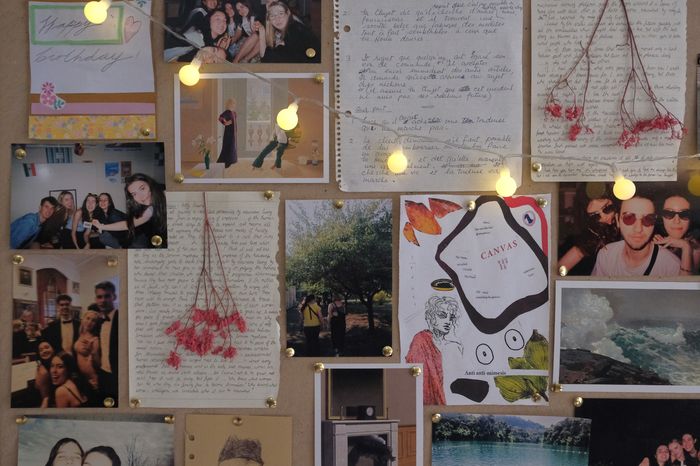Bitter gusts punctuate Sidney street, affirming I am again in Cambridge. Emily Lawson-Todd’s room feels entirely separate from the hostility of the city, offering an enveloping warmth. With sprawling windows overlooking King Street, self-confessing to being “really nosey” it is the perfect perch for the journalistic curiosity she exudes. Observing everything from break-ups to fights, her view is as fascinating and eclectic as her room, a tapestry of moments, memories and acquisitions. Subtly curated, Emily’s artistic flair weaves itself through every item. The sunny orange colour palette is freckled with flecks of vibrant green from numerous fake plants — though she “can’t keep anything alive”, her room is far from devoid of life.
“Her hand-painted fish mug, nestled next to a water bottle of watercolour koi or her elephant garland forge a tapestry, an inhabitable art”

Vibrancy consumes the well-worn sage candlesticks adorning old wine bottles, bunting brushing against the blurry film photos that Emily has “magpied”. The “magpie-ing” extends to her rich blue rug, wilfully surrendered by her parents. “There’s photos of me on this rug from when I was little,” — it’s more than a centrepiece. More than tying together a room, or providing somewhere to put your feet when clambering out of bed in the cold winter months, it offers a chronology of Emily’s room, incorporating every iteration of herself. The white pinpricked paper star echoes this continuation, a first-year Michaelmas birthday present that has been put in “all the rooms I’ve lived in and has just been a bit of a constant”, or her mum’s green ’90s necklace, a recent unearthing, mediating Emily’s “mourning” of the leather coat her mum discarded.
Her fireplace, or “yee-haw corner”, owing to the residence of her banjo and cowboy boots, litters the space with artistry. While others “have made them into mini-shrines”, including one honouring Danny DeVito, Emily’s houses “some remnants of the tragedy paper” and boasts the postcard of a home nightclub from her mum. Emily believes “I can find sentiments everywhere,” even in “sticky floors and £2 jagerbombs”. Her room is swelled with traces of her illustrative talents, and she admits her “love [of] looking at spreads. Just going through papers and looking at how they’ve set out the pages.” Like the tapestries above her bed, each object amounts to a patch of fabric, in isolation unremarkable, but when viewed in harmony with her hand-painted fish mug, nestled next to a water bottle of watercolour koi or her elephant garland, it forges a tapestry, an inhabitable art.
If her room were an exhibition, Emily would title it: “A whole lot of tat”. ‘Tat’ may feel at first affronting, casting aspersions on the value contained within her cream walls; people rush to defend the value of freshers’ first day pictures, her friend dressed as Dolly Parton, or the incidentally dried flowers, forging themselves as the focal point of her mantlepiece. But so what if it is ‘tat’? It’s not so much “little fragments of the everyday but it’s more just a room and I live in it… I don’t know why you would want to be somewhere with white walls.” Like the early modern people of her seminars, Emily fills the feared “blank space” of “white walls” with tapestries. Is there any harm in having things, having ‘tat’ for nothing other than filling “white walls”? Part of me wishes she indulged in the sixth form tongue-in-cheek humour she used in titling her room “the Pleasure Dome”, a knowing nod to Coleridge’s Kubla Khan.
“Emily’s room is more than ‘white walls,’ but a tapestry of the past and potential”
While physical representations of university birthdays and cousins’ Christmas presents are great, they are just material items: while you can always buy more ‘tat’, it is their sentimentality we are compelled to savour. “I really like the idea of holding on to things—but also if you don’t love something, just sell it again and make something out of it.” Emily’s room straddles the line between sentimentality and dynamism. A growing jumper collection accumulates beside her desk, the product of numerous years of charity shop purchases and depop scrolling. But she could just as easily be rid of her possessions, just as she sheds New Yorker postcards to friends, her collection adorning not just her mantlepiece but enshrining her friendships. Most of her possessions are “not exactly what you want or near to exactly what you want, but it turns out to be just the thing”. She “make[s] something” out of every sliver of space and fragment of objects.

Emily claims she “cannot keep a surface clean”, but why would you want to, with life model sketches as your mouse pad and Shakespeare tossed by your pillow; while she may “never get [my] deposit back”, I think it’s worth it. Emily’s room is more than “white walls” but a tapestry of the past and potential.




